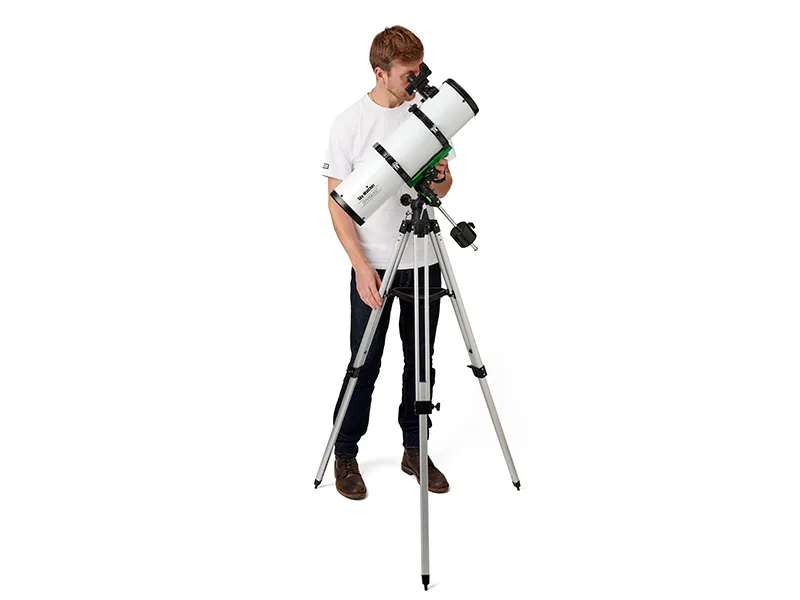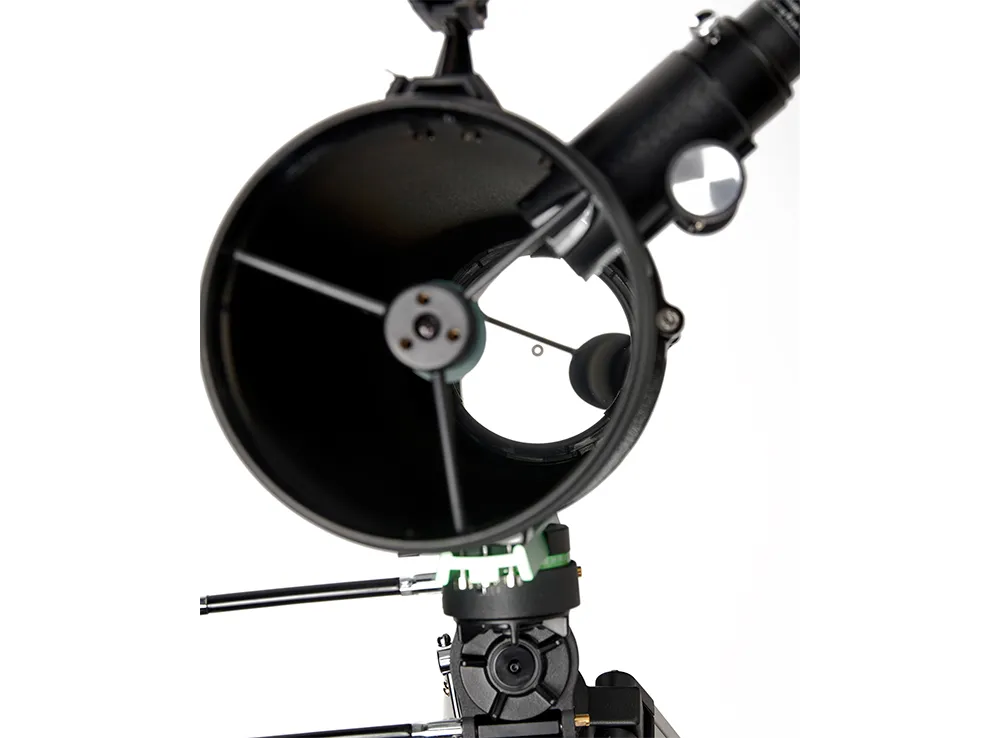Looking smart and fresh in its white, black and green livery, the Sky-Watcher StarQuest 130P Newtonian reflector’s tube length is nice and short, so it’s not unwieldy for newcomers to handle.
The tube holds a 130mm primary mirror with a focal length of 650mm, which gives a focal ratio of f/5.
The mount gives a fresh take on traditional EQ1 and EQ3 designs. It’s more compact, using Capstan-style locking clutches and is a much smaller size, which helps to make it lightweight, yet robust.
Slow motion controls are included for both axes, while the mount can also be adjusted to be an altazimuth style if needed.
The mount sits on an aluminium tripod with an accessory tray for the two supplied eyepieces: 25mm giving 26x magnification and 10mm giving 65x.A red dot finder, counterweight and bar completes the setup.
This telescope features in our lists of the best telescopes for beginners and best budget telescopes

The system only weighs 8kg and it’s easy to assemble, which means the StarQuest 130P is much more likely to get used than a more awkward setup, and less likely to get left in corner of a room without any action.
We checked the collimation of the optics and found they were still aligned despite the transportation, so we went straight to work, late into the next clear night.
Optically the system is classed as ‘fast’ at f/5, so we looked at Altair (Alpha (α) Aquilae) and noted how the star appeared from one side of the view to the other using the 25mm eyepiece.
Altair appeared as a good tight pinprick for 70% of the view, but then showed some distortion towards the field edges, which is on a par with many other scopes we have tested.
We then viewed the wonderful double star Albireo (Beta (β) Cygni) in Cygnus, first with the 25mm eyepiece and then with the 10mm. The colours were well defined with gold and sky blue, and the components were clearly separated with dark space between them.
We also had a good view of Gamma (γ) Andromedae, which appeared as a tighter version of Albireo, and it was also a pleasing sight when we added our own 2x Barlow lens.

Turning to the summer sky we took a tour from high up in the constellation of Cygnus, the Swan, starting with star cluster M39, which looked like a sprinkle of diamond dust with its clearly defined triangular nature.
Other clusters we viewed included its smaller cousin, M29 and the Wild Duck Cluster, M11, showing a strong hint of the ‘V formation’ of stars that gives it its name.
The Sagittarius Star Cloud looked mottled with the 10mm eyepiece; and later in the night we were rewarded with a sparkling view of the Pleiades, M45, low in the east and framed nicely in the 25mm eyepiece.
Turning to nebulae we began with a favourite, the Omega Nebula, M17, while its neighbour, M16 was more impressive as it revealed the cluster with a hint of haziness surrounding it.
Higher up, the Dumbbell Nebula, M27, was well defined and the 10mm gave a good view too.

Over in the constellation of Lyra, the Harp, we had a good view of the Ring Nebula, M57, in the 10mm eyepiece – with a nice ‘hollow’ to its ring on display.
Switching to the 25mm we viewed galaxy pair M81 and M82, with both fitting in the eyepiece view, the former was revealed as a hazy oval and the latter as a sliver of light.
The almost full Moon fitted in the field of view of the 10mm, revealing lots of detail – it was rewarding to watch the changing phase with this scope and see how it highlights the craters and seas.
Although it’ s not an imaging scope, we successfully attached a smartphone adaptor to the 25mm eyepiece and zoomed in to capture a lunar image with our iPhone XR.
Overall, the StarQuest 130P is a well-made and easy-to-use telescope that will give a lot of pleasure to first-time stargazers; it could also work as a simple grab-and-go option for more advanced observers.

Sky-Watcher StarQuest 130P Newtonian reflector's mount
Equatorial mounts for ranges of smaller telescopes can often look a little clumsy, difficult to use and quite frankly old-fashioned, but the mount with the StarQuest 130P is an interesting, more compact and modern design.
This makes it easier to set up and use, especially as it comes as one unit ready assembled. Just pop it onto the tripod, bolt it in place and then put the scope onto the Vixen-style head, and you are ready to go.
It uses Capstan-style locking knobs on both axes, which replace the more traditional side knobs; and we found that after a little practice it became second nature to loosen these to make large-scale adjustments to the direction the scope is pointing.
The mount also has two slow-motion controls for fine tuning in both RA (right ascension) and dec. (declination) settings, which were smooth and easy to use. It can also be configured in an altazimuth position, which is useful for viewing awkward to reach areas of the sky such as near the celestial pole, or for viewing landscapes during the day.
Sky-Watcher StarQuest 130P's best features
Tube rings
The tube rings safely hold the telescope in place via locking bolts that can be slightly loosened to allow the tube to be rotated for a more comfortable viewing position. They attach to the mount via a standard Vixen-style bar which is a fetching metallic green.
Eyepieces
Two basic eyepieces with rubber eyecups are supplied, a 25mm giving 26x magnification and a 10mm for a higher 65x magnification. They work well for this focal system and give pleasing views of a wide range of celestial targets, from lunar to planetary and brighter deep-sky favourites.
Tripod
The aluminium tripod is a good match for the StarQuest 130P, as it is lightweight yet strong enough to support the telescope. It has adjustable legs to make the viewing height more comfortable and a useful accessories tray, which helps to spread the tripod’s legs and lock them in position.
Focuser and finder
The focuser is a standard rack and pinion style that takes 1.25-inch fit eyepieces. We noticed there was a little play when focusing, but nothing serious. The finder is a standard red dot type with adjustable brightness, so as not to overpower the view at its lowest setting.
Optics
The 130mm (5.1-inch) parabolic mirror has a relatively short, or ‘fast’, focal length of just 650mm, giving the system a focal ratio of f/5. Along with the secondary mirror, it is housed in a white aluminium tube, which makes it lightweight and easy to handle.
Vital stats
- Price £199
- Optics 130mm (5.1-inch) parabolic mirror
- Focal length 650mm (f/5) focal length
- Mount Equatorial/altazimuth mount
- Focuser Rack and pinion
- Extras Red dot finder, 1.25-inch 10mm and 25mm eyepieces, slow-motion control cables
- Weight 8kg
- Supplier Optical Vision Ltd
- Tel 01359 244200
- www.optical vision.co.uk
This review originally appeared in the December 2020 issue of BBC Sky at Night Magazine.
